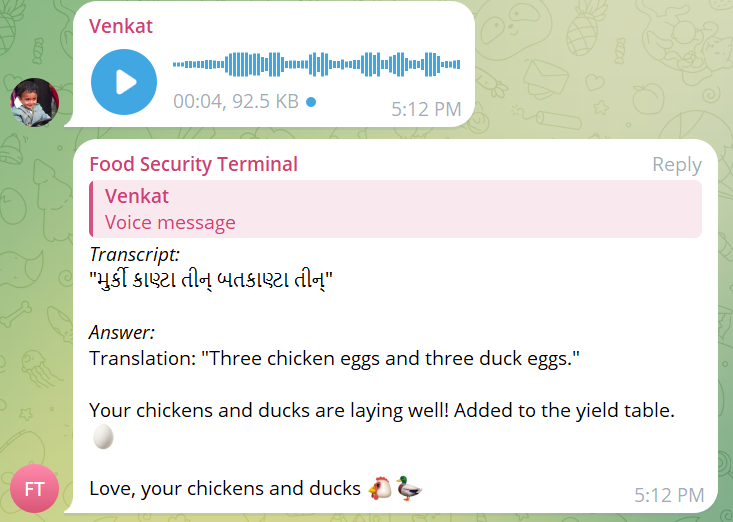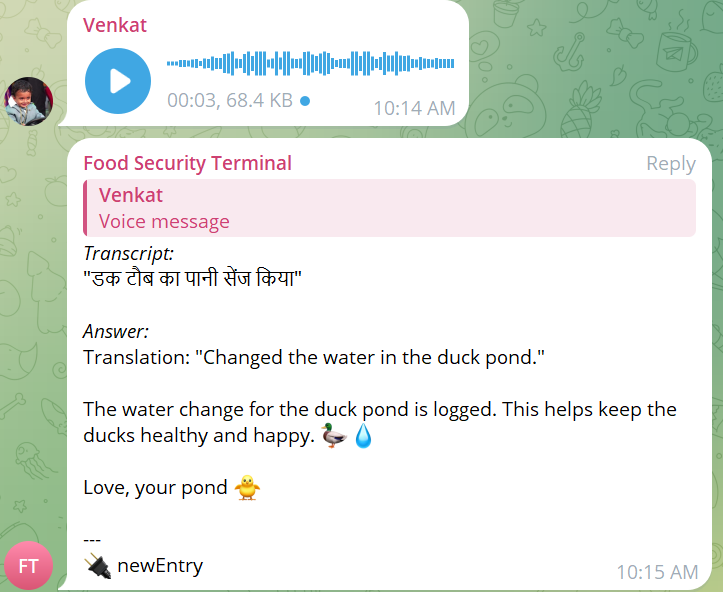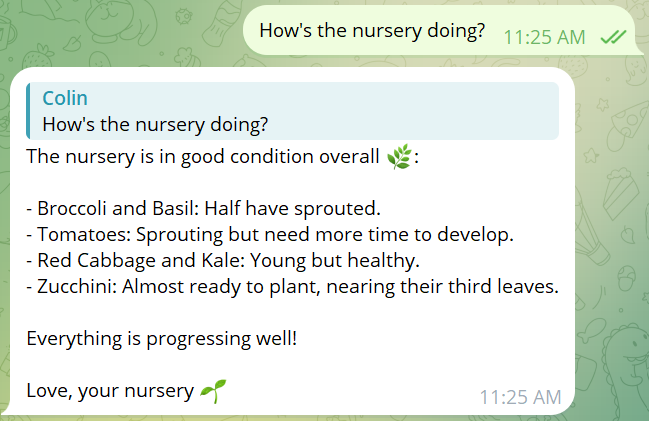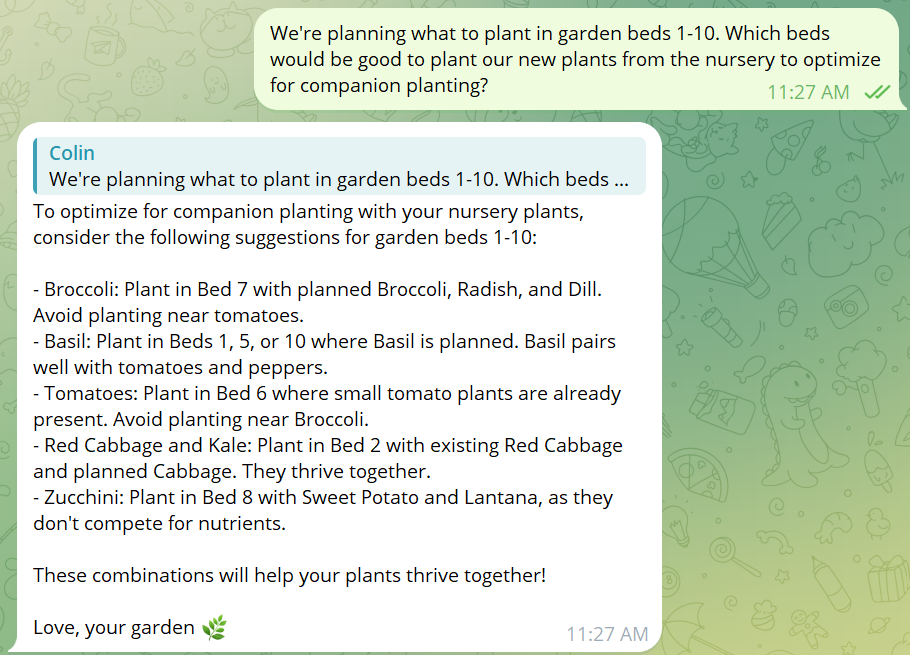The Food Security Terminal
Intro: Enhancing Global Food Security
The Food Security Terminal creates digital twins of food systems, combining human observation and generative AI to optimize yield, climate resilience, and biodiversity.
Key Features:
- Data Collection: Gather field journal entries through voice, text, and image inputs via a Telegram bot.
- Digital Twin Creation: Extract structured and semi-structured data on plant and animal lifecycles, objects, and locations to create a living model that tells the story of everything on the farm.
- Decision Intelligence: AI-generated reports, metrics, charts, and knowledge lookup to practically guide the optimization of the system.
- Guided Real-World Action: Task management and long-term optimization focused on regenerative methods, climate resilience, food production, and biodiversity.
Pilot Project: Learn to Grow Outdoor Educational Center
Our pilot project is underway at Learn to Grow Outdoor Educational Center and Permaculture Farm in Bahrain, an outdoor educational center where children and adults can connect with nature. The project teaches hands-on skills to cultivate sustainable food systems in challenging growing conditions while promoting environmental stewardship and climate resilience.
Live Update: A letter from the garden AI Live from the farm
Dear growers,
As the summer sun begins to mellow, our garden is bustling with life and activity. Spinach, loofa, and butterfly blue pea are ready to leap into your baskets, while chili peppers, tomatoes, and eggplants are ripe for the picking. Our feathered friends have been busy too, with chicken and duck eggs aplenty!
This month, we're sowing the seeds of future feasts with butterfly blue pea, zucchini, and pumpkin in the nursery, and spinach, carrots, and marigolds in the ground. The passion fruit is passionately growing in the back area, and new cuttings of mulberry, lime, and fig are settling into their potted homes.
Our soil is as rich as chocolate cake, thanks to the summer mulch and diligent composting. However, some pesky spiky grasses are trying to steal the show. Fear not, for our trusty low grass is perfect for pulling and mulching.
Watering is a thrice-weekly affair, with a special focus on our thirsty eggplants. We've also ensured a clean splash for our ducks by refreshing their pond.
The garden is abuzz with bees and the occasional falcon soaring overhead, a testament to our thriving ecosystem. However, a few ants and mosquitos are trying to crash the party, and our cabbage heads are under siege. But with yellow sticky traps and a dash of neem, we're on the case.
Please keep an eye on the big snake in Bed 08 and the chicks' allergies. And remember, our eggplants need a little extra love to start fruiting.
Thank you for your continued care and attention. Together, we're growing something truly special.
Love, your Learn to Grow garden.
Structured Data Extraction: Real-Time Yield Metrics Live Data
kg Harvested
Total
3,260
This Year
214
This Month
16
This Week
5.0
Today
2.9
Eggs Harvested
Total
3,385
This Year
1,494
This Month
39
This Week
10
Today
0

Field journal entries are parsed for yield and harvest data. The database is updated with the item, amount, kg equivalent, and date. The table below shows the live yield harvest.
Live Yield Charts Live Data
Breaking Language Barriers: Multi-Lingual Interactions

Our gardeners speak to the bot in their mother tongue language to share observations, task updates, and yield. Everything is logged in the database for me to view and manage centrally in English. We have seen a huge increase in the amount and quality of information communicated, meaning the garden is better managed.
Semi-Structured Data Storytelling: Location Status Tracking
Walking around the farm, we send voice notes with what we observe - lifecycle growth, animals and pests, and overall impressions. Keywords and statuses are extracted and the corresponding dossiers are updated in the database.

We can then ask about the status of different locations, plants, animals, or even objects.

Decision Intelligence: Garden Planning based on tracked location and plant statuses
With direct access to the tracked information about the plants and locations, we can better plan and react to what’s happening in the garden.

Task Management: From Observation to Action
Actions can be created and completed through entries. Below are the current open tasks on our farm.
Live Task Dashboard: Open Actions Live Data
| Object | Task | Created At | |
|---|---|---|---|
| Loofa | Make new loofas from those that have fallen and are lightly damaged. | Feb 25 | |
| Chicken, Duck | Consider fencing areas like the sunken garden and worm wonderland to keep chickens and ducks in the food forest. | Jan 27 | |
| Jalwas | Consider solutions like lining with wood or using clay to reduce permeability and erosion. | Jan 27 | |
| Nets | Consider using nets for bird control. | Jan 27 | |
| Garden Beds | Make new signs for the new garden beds that don’t yet have labels. | Mar 26 | |
| Garden Beds | Make extra signs to label new areas. | Mar 26 | |
| Wooden Structure | Plan how to build the wooden structure and offer placement options. | Mar 26 | |
| Wooden Structure | Discuss the wooden structure plans and placement options. | Mar 26 | |
| Chicken Eggs | Check for chicks hatching from the incubator. | Dec 15 | |
| Moringa | Cut one of the moringa trees back heavily and observe its regrowth and speed. | Dec 24 | |
| Eggplant | Plan to try brushing for pollination. | Jan 27 | |
| Chicken | Manage or check on chickens in the designated area. | Feb 28 | |
| Trash | Trash removal is needed in the wild area. | Jan 27 | |
| New back beds | Label new back beds. | Jan 27 | |
| Potato | Harvest the potatoes that are ready. | Feb 12 | |
| Loofa | Work processing for loofa is currently ongoing. | Mar 02 | |
| Tomato | Plant new tomatoes. | Feb 12 | |
| Compost | Monitor the compost piles for readiness. | Oct 22 | |
| Signs | Create 5 large signs and 10 smaller signs for the new garden beds. | Jan 28 | |
| Potato | Potatoes will be harvested to make space for tomatoes. | Feb 13 | |
| Blue Flower | Move the blue flower opposite the nursery. | Feb 13 | |
| Crown Flower | Add more mulch to beds 15 and 14 to protect crown flowers. | Feb 13 | |
| Garden | Consider trimming back overgrown areas or removing netting to maintain tidiness. | Apr 05 | |
| Sunflower, Nasturtium | Plan to plant more sunflowers and nasturtium next year. | Dec 30 | |
| Back Beds | Clean the back beds to maintain plant health. | Apr 06 | |
| Nursery | Plan to start shading the nursery to protect seedlings. | Apr 06 | |
| Mango | Fertilize the mango trees to promote healthy growth and fruit production. | Apr 06 | |
| Fruit Fly Traps | Hang fruit fly traps to prevent infestation and protect the mangoes. | Apr 06 | |
| Tomato | Plan to have more quality tomato plants next year. | Dec 30 | |
| Eggplant | Plan to increase watering frequency for the eggplants. | Apr 06 | |
| Eggplant | Monitor the eggplant in bed 25 and try hand pollination. | Apr 06 | |
| Mulberry | Dehydrate the other part of the mulberry batch to observe the results. | Apr 06 | |
| Chicken | Continue administering medicine and home remedies to the sick chicks. | Apr 08 | |
| Coop | Construct a new small chicken coop. | Mar 13 | |
| Compost | Manure is needed to make a new compost. | Apr 08 | |
| Chicken, Duck | Perform a full cleaning of the chicken and duck coops and fenced-in area. | Apr 09 | |
| Grass | Rake out the floor and replace it with freshly pulled grass. | Apr 09 | |
| Tomato | Hang tomatoes in the back area beds. | Feb 02 | |
| Brassicas | Monitor the brassicas closely for aphid infestation. | Feb 20 | |
| Cauliflower | Harvest the cauliflower heads as they are unlikely to grow bigger. | Apr 09 | |
| Cabbage | Harvest the cabbage that is ready. | Apr 09 | |
| Soil | Prepare the soil again for the cuttings. | Apr 09 | |
| Carrot | Plan to keep harvesting carrots. | Apr 09 | |
| Mango, Compost | Put compost on mango trees as a volunteer activity. | Apr 10 | |
| N/A | Clean fields as a volunteer activity. | Apr 10 | |
| N/A | Seeding for summer season as a volunteer activity. | Apr 10 | |
| Loofa | Transplant loofa as a volunteer activity. | Apr 10 | |
| N/A | Tidy up the nursery as a volunteer activity. | Apr 10 | |
| Palm Tree | Explore using palm tree wood for furniture and materials. | Feb 22 | |
| Palm Tree | Explore eating the core of the palm tree. | Feb 22 | |
| Bees | Discuss with Ali, the beekeeper, about getting a new queen bee. | Nov 19 | |
| Chicken | Take the chicks outside to get some sun. | Feb 06 | |
| Tools | Fixing the lights outside using tools. | Mar 20 | |
| Sugarcane | Continue clearing sugarcane in the wild zone. | Oct 22 | |
| Lime | Check for roots on air-layered lime branches. | Nov 08 | |
| Peanuts, Potato | Plan to plant peanuts and potatoes at the beginning of next year, around September. | Nov 28 | |
| Signs | Create 10 small signs and 5 large signs for labeling new garden beds. | Dec 03 |
Terminal: Long-Term Vision
The objective of Food Security Terminal is to generalize into Terminal - a platform that builds digital twins of physical systems to guide human action towards optimizing for the systems' objectives. On the farm, that's yield, climate resilience, and biodiversity.
Food systems are highly observable, slow, and mistakes are low-impact. That's why we've started there. Once we get it right, we will soon move to maintenance, supply chain, property management, and the management of other physical systems.
Future Developments
- Shared Knowledge Base: Collectively create a knowledge base on the best methods and insights on the what, when, and how of growing food.
- Proof-of-Journey NFTs: Blockchain-validated histories including plant lifecycles, observed properties, pest management, and harvest.
- Decentralized Farmers' Market: Multi-attribute marketplace to guide the physical exchange of objects with blockchain-validated histories.